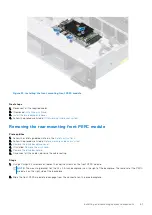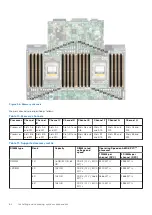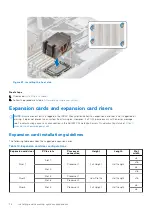
●
The BIOS Setup menu presents the applicable NPSx options based on the underlying model number. A change to the current
NPSx is communicated to pre-BIOS firmware to take effect on the next boot. The default NPS setting is 1.
●
During boot, if the selected NPSx option is not allowed for the model number (for example, if the processor model number
changes between reboot), system will halt at the end of POST with UEFI0388 message displayed. On the next reboot, the
system will fall back to NPS1 default setting.
●
During boot, if the preferred interleaving for the current NPSx is not possible due to memory configuration (for example, the
memory population is inconsistent with the preferred interleaving), BIOS shows a warning message UEFI0391.
NOTE:
System is functional when UEFI0391 message is displayed. However, the system may not be configured for
optimal performance.
NPS system optimization
Optimal system configuration is dependent on the processor model, memory configuration, and NPS settings. The following
processor modules are supported:
●
75F3
●
7763
●
74F3
●
73F3
●
7713
●
7543
●
7513
●
7453
●
7443
●
7413
●
7343
●
72F3
●
7313
Table 13. Optimal NPS configuration
Number of
DIMMs per
processor
NPS
0
1
2
4
1
X
2
X
3
X
4
X
5
X
6
X
7
X
8
X
X
9
X
10
X
11
X
12
X
13
X
14
X
15
X
16
X
X
●
Recommended NPS setting is marked by X that indicate optimal performance.
●
NPS0 is only available for dual processor systems and is the preferred setting.
●
The NPS setting that are blank are functional. However, indicate non-optimal performance.
66
Installing and removing system components
















































